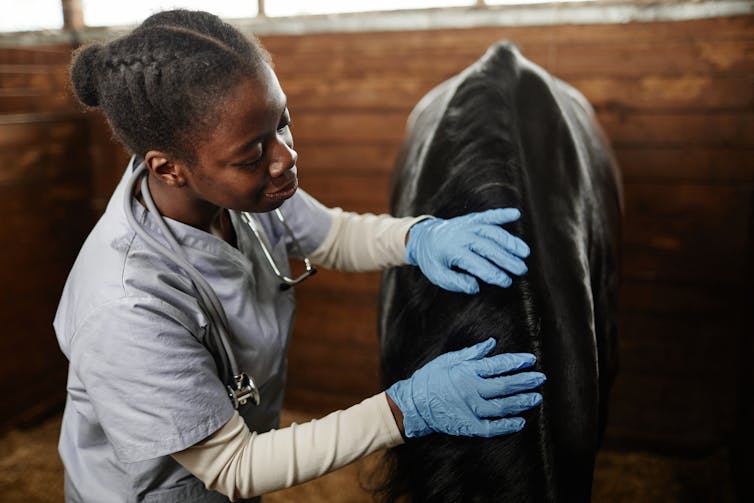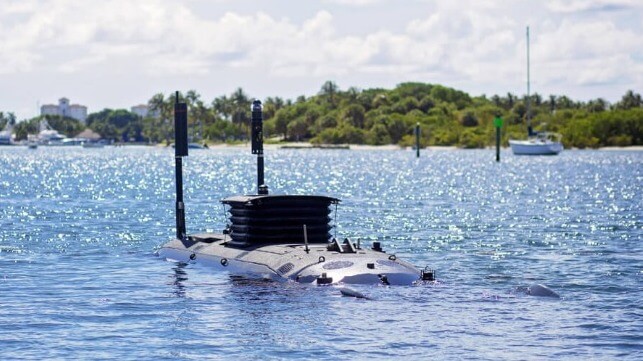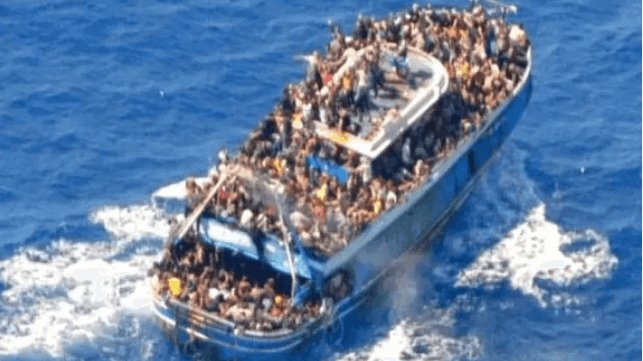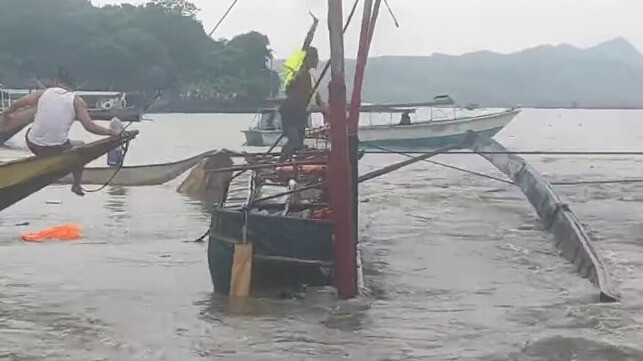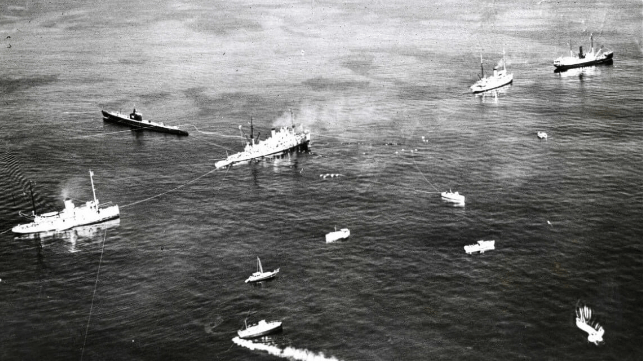The Conversation
July 25, 2023,

The NASA logo at the entrance to the Kennedy Space Center Visitor Center, Cape Canaveral, Florida. - Dreamstime/Dreamstime/TNS
Sixty-five years ago, in 1958, several government programs that had been pursuing spaceflight combined to form NASA. At the time, I was only 3 years old.
I’ve now been a professor of physics and astronomy for nearly 30 years, and I realize that, like countless others who came of age in the 1960s and ‘70s, NASA’s missions have had a profound effect on my life and career path. From John Glenn’s first flight into orbit to the Hubble telescope, the agency’s legacy has inspired generations of scientists.
First flight into orbit
The date was Feb. 20, 1962. My first grade teacher, Ms. Ochs, told the class that we would be doing something different on that day. She went to the blackboard and wrote in large block letters “John Glenn” and “NASA.”
She asked if any of us knew what those words meant. None of us did, so she grabbed a globe, and using a pen with a plastic cap, she demonstrated that John Glenn, an astronaut, would soon be launched on a rocket – the pen – from Florida. When the rocket got high enough, Glenn in the Mercury capsule – the cap – would separate from the rocket and go into orbit around the Earth. She demonstrated this by moving the pen cap around the globe.
My class then sat and listened to the historic launch of Friendship 7 carrying Glenn, which was the first U.S. mission to send a man into orbit around the Earth.

During the Gemini mission, two spacecrafts attempted the first-ever space rendezvous. This image, taken in the Gemini 6 craft, shows the Gemini 7 craft just 43 feet away. NASA
There would be three more missions in the one-manned Mercury program, culminating in Gordon Cooper’s Faith 7 mission, which completed 22 Earth orbits. The program proved that NASA could put a manned spacecraft in orbit and bring it back safely to Earth. Next, NASA was ready to move on to a more maneuverable two-person spacecraft.
A two-person spacecraft
In 1965, NASA planned to launch the two-person Gemini spacecraft, and I moved on to the fifth grade where my teacher, Mrs. Wein, was also a space enthusiast. In December, NASA launched the joint missions of Gemini 6 and 7, and Mrs. Wein gave me permission to stay home from school to watch the TV coverage.
This was the first time that two piloted spacecraft performed what is called a rendezvous maneuver, where they meet up in orbit. Orbital maneuvers like this require very precise calculations and a spacecraft in which astronauts can make path changes in orbit – which is what the Gemini capsule was designed to do.

A lunar orbit rendezvous occurs when a smaller lunar lander breaks off a main spacecraft while in orbit to land on or circle the Moon before returning to the main craft.
The Gemini 6A and 7 spacecrafts practiced a rendezvous maneuver in Earth’s orbit. At the time, I didn’t understand the importance of this mission, until Mrs. Wein directed me to the “S” volume of the World Book Encyclopedia. There, under “Spaceflight,” was a full-page diagram of the lunar orbit rendezvous plan that a NASA engineer, John Houbolt, had developed to get the astronauts to the Moon and back.
The central feature of the lunar orbit rendezvous was that two spacecraft, the Apollo Command Module and the Lunar Excursion Module, would rendezvous in orbit around the Moon using the same technique the Gemini 6 and 7 missions had demonstrated. The technology of this maneuver, used in Apollo missions, would later help land Neil Armstrong on the Moon.
On to the Moon

‘Earthrise,’ captured by the Apollo 8 mission, was the first look at Earth from afar.
In December 1968, when I was in eighth grade, I watched the Apollo 8 mission orbit the Earth on TV. It was the first time that anyone, whether U.S. astronaut or Soviet cosmonaut, had left low Earth orbit. This mission gave us “Earthrise”, the first look at our home planet as seen from afar.
The Apollo 11 Moon landing happened in July 1969. I will never forget sitting in my living room as Armstrong stepped off the Lunar Excursion Module onto the lunar surface. With Armstrong’s steps, the aspirations of a lost president, thousands of NASA scientists and engineers and millions of public followers were fulfilled.
CBS News anchor Walter Cronkite captured the wonder of the moment when he slowly removed his glasses, rubbed his hands together and exclaimed, ‘boy.’
In December 1972, when I was a senior in high school, Gene Cernan became the last person to walk on the Moon during the Apollo 17 mission. Like many of us who witnessed the Apollo missions, I listened to Cernan’s final words from the Moon, where he challenged young people to continue what NASA had begun.
Inspired by Cernan’s words, I went on to earn degrees in aerospace engineering and worked on both the reentry of the Skylab Space Station and the early mission planning for the Magellan spacecraft that visited Venus.
At this point, I made a career change – I returned to school to study physics and ultimately ended up in theoretical astrophysics.
After Apollo
NASA has had a profound influence in the sciences. For one, the ability to guide unmanned robotic spacecraft anywhere in the solar system was a byproduct of the technologies necessary for the manned Apollo missions. Using this technology, NASA has sent probes to all of the planets – and some non-planets – in the solar system, revolutionizing scientists’ knowledge of our cosmic backyard.
Perhaps the most ambitious of these is the Mars Perseverance Rover, which looks for chemical evidence of past or present life on Mars. It also collects and leaves samples for a potential return mission sometime in the 2030s.
In terms of pure astronomy, NASA’s space-based observatories span the electromagnetic spectrum. The Hubble Space Telescope and its newly launched cousin, the James Webb Space Telescope, have allowed astronomers to get large telescopes above Earth’s optically hazy atmosphere. With these instruments, we can see almost to the beginning of time, since looking deeper into space also means looking back in time.
The James Webb Space Telescope is revolutionizing our view of the cosmos – there has not been an equal revolution in observational astronomy since Galileo first pointed a telescope at the heavens in 1609.

Images from the James Webb Space Telescope showing early galaxies.
Looking ahead
What will the future hold for NASA? It’s hard to say.
Recently, private enterprise has driven advances in both launch vehicles and satellite design, although NASA will likely continue to have a leading role, not only in the spaceflight but the scientific research as well.
I hope that today there are elementary teachers like Ms. Ochs and Mrs. Wein who will nurture the wonder and excitement of spaceflight in their students. But they won’t have to just listen on the radio. They can watch livestreams, like those of launches of SpaceX’s Falcon Heavy in 2018 and NASA’s Artemis I in November 2022.
NASA’s first 65 years have been an amazing record of accomplishments. When the students I teach today near my age, I wonder what amazing things – about which we can only dream – they will look back on.

Stephen G. Alexander, Associate Professor of Physics, Miami University
This article is republished from The Conversation under a Creative Commons license. Read the original article.



